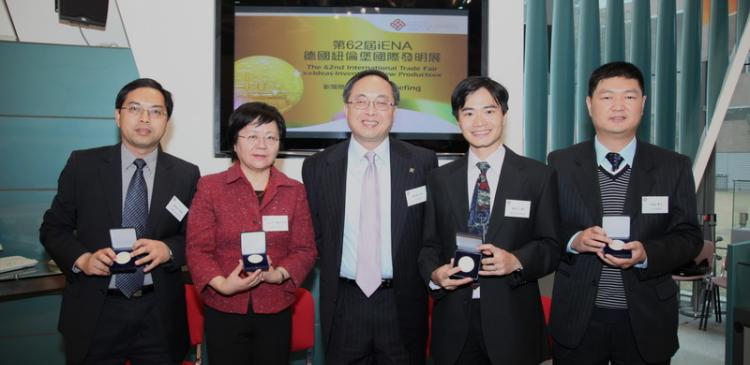PolyU Executive Vice President Mr Nicholas W. Yang and the Principal Investigators proudly presented their medals on the 15th December at a press briefing held in the University’s House of Innovation. They also explained the applications of these award-winning projects in different settings.
The winning entries presented by PolyU and their respective Principal Investigators are listed and briefly described as follows:
(1) Gold Medal: Exoskeleton Hand Robotic Training Device
Principal Investigator: Dr Raymond Tong Kai-yu,
Department of Health Technology and Informatics
Jointly developed by the Department of Health Technology and Informatics and the Industrial Centre, this rehabilitation device is specially made for stroke patients to actively recover their hand functions by using exoskeleton robot with muscle signals. It detects the intention of hand opening or hand closing from the stroke patient using his/her muscle signals measured by surface electromyography (EMG) from the hemiplegic side. The sophisticated device is made up of an embedded controller and a robotic hand module. It allows much flexibility as each finger assembly can also be adjusted to fit for different finger length. With the use of this light and portable robotic device, stroke patients can practise more easily for the opening and closing of hands at their own will, and handle functional daily living tasks at ease.
The Principal Investigator Dr Raymond Tong is dedicated to the study of advanced rehabilitation technology for stroke patients. He has also played a key role in the research and development of PolyJbot, a rehabilitation system driven by human intention, with applications in a wide range of settings from hospitals and clinics to elderly home. In 2008, Dr Tong was honoured by the Hong Kong Institution of Engineers with the HKIE Innovation Award for Young Member in recognition of his distinguished accomplishment.
(2) Silver Medal: Digital Image/Video Quality Enhancement System
Principal Investigator: Dr Zhang Lei, Department of Computing
Developed by computing experts of PolyU, this Digital Image / Video Quality Enhancement System can be applied for digital camera, HDTV and other consumer electronics, enabling consumers to enjoy higher-quality digital images and videos. Compared to the current techniques, PolyU-developed system is better in terms of its multiple functions and potential applications. It can improve the quality of image right from the raw video stage and process short films shot by common home video cameras and mobile phones and even traditional film movies, solving such problems as too many noises and blurs.
In addition, this enhancement system can be used for repairing static digital images. It can reconstruct the blurred videos with its super resolution technology, sharpen the fineness of the image profile, and improve the overall quality of images to the point of meeting the requirement of enlarged poster output. This project was kicked off in 2009 with a $1 million grant from the Government's Innovation and Technology Fund. PolyU researchers have filed a patent for this innovation in the US.
(3) Silver Medal: O-breath – Respiration Monitoring in NMRI Room
Principal Investigator: Professor Tao Xiao-ming, Institute of Textiles and Clothing
For medical personnel and patients alike, the monitoring of vital signs such as respiration rate is an important task in the hospital and clinical settings. The design of monitoring device has to meet the dual objectives of accuracy and non-interference with other medical equipment. This gave rise to the concept of O-breath, a wearable system featured with a textile belt integrated with polymeric optical fiber sensors in Nuclear Magnetic Resonance Imaging (NMRI) Room.
O-breath is a photonic strain sensing system which is developed for detecting repeated large deformation. The central part is the fabric based strain sensor. The sensor consists of three essential components, namely an elastic textile fabric, a series of looped polymer optical fiber, on which specially designed v-groove are made by laser cutting, and unique joint structure which facilitates the deformation mode required by the v-groove optic fibers. The light transmission power of the integrated polymer optical fiber is measured during deformation. This fabric optical sensing device is immune to electromagnetic interference. Moreover, its maximum working range would be up to 30% strain with high repeatability and low hysteresis, making it perfectly suitable for use in applications such as nuclear magnetic resonance imaging and underwater respiration-rate monitoring. It also has great potentials for various applications, including wearable electronics, robotics, health care and industrial engineering.
(4) Silver Medal: 3D Ultrasound Imaging for Spine Scoliosis
Principal Investigator: Professor Zheng Yongping,
Department of Health Technology and Informatics
Adolescent Idiopathic Scoliosis (AIS) is the most common spinal deformity among children, and its prevalence accounted for 2-4% of the population. Early detection is necessary to rectify the problem as soon as possible and continuous monitoring is crucial during treatment.
Although X-ray images are most widely used for the measurement of spine curvature for quantifying the severity of scoliosis, the method itself poses a radiation hazard and thus cannot be used frequently for children and adolescents, particularly for female kids. With this in mind, PolyU researchers have developed a novel, radiation-free system for scoliosis evaluation based on advanced 3D ultrasound imaging techniques. In addition to the lateral curvature measured by X-ray, it can also provide the rotational information of spine deformity. Due to its mobile feature, the new system can be installed anywhere for screening and assessment purposes. Besides, the curing effect can be continuously monitored by the system during the period of treatment, as the 3D ultrasound scanning can be conducted as frequently as needed. The device can also be used for assessing the deformity of spine other than AIS. Clinical trials are now being conducted through the collaborations with local clinics and hospitals. Professor Zheng's team is also working with a local company to commercialize the novel system, which can ultimately benefit many kids and other patients.
The 62nd International Trade Fair "Ideas - Inventions – New Products" was held from 28-31 October in Nuremberg. It provided a platform to display more than 800 inventions and product innovations from 37 countries and territories.




